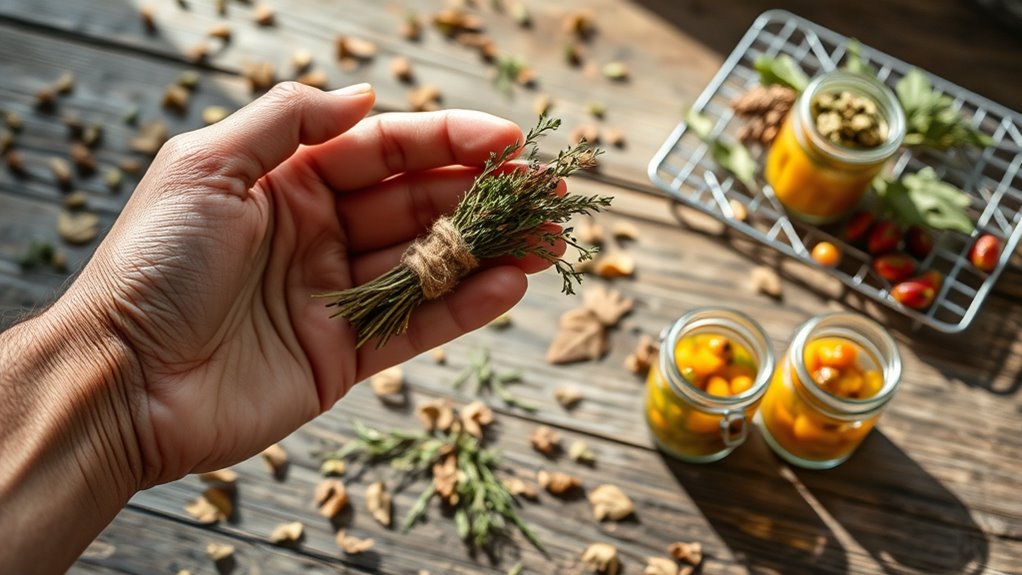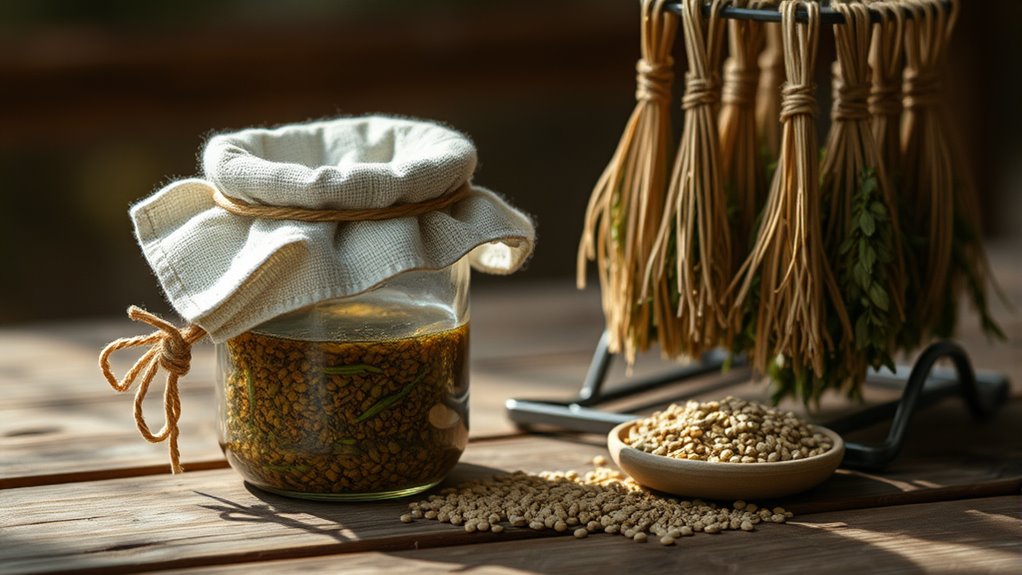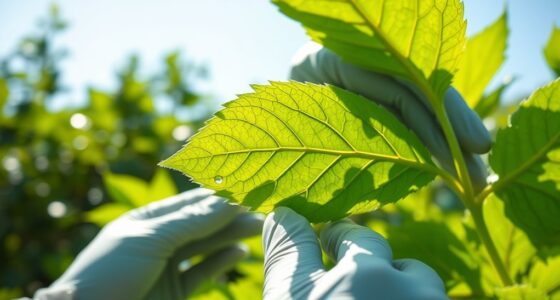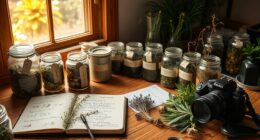To preserve herbs, vegetables, and fruits in the field, use simple, portable techniques like drying herbs on small screens or drying mushrooms with a lightweight dehydrator. Fermentation can be done in sealed jars with minimal equipment by monitoring temperature and moisture. Vacuum-sealed bags help extend shelf life, and choosing sturdy containers keeps your supplies safe. Keep exploring these easy tricks to maximize your harvest and stay prepared in outdoor situations.
Key Takeaways
- Use lightweight, sealed jars for fermenting small batches of vegetables or fruits in the field.
- Employ portable drying methods like solar dehydrators or air drying for herbs and mushrooms.
- Opt for vacuum-sealed bags to extend preservation and save space during field storage.
- Maintain proper conditions: keep containers clean, dry, and well-sealed to ensure successful fermentation and drying.
- Incorporate multi-purpose containers to facilitate quick switching between drying, fermenting, and storage tasks.

Have you ever wondered how to keep your valuables safe and organized on the go? When you’re out in the field, whether hiking, camping, or exploring, portable storage becomes your best friend. It’s crucial to have a compact, reliable way to carry and protect your items, especially when dealing with delicate or perishable goods. This is where on-the-go preservation methods come into play, allowing you to extend the life of your harvest or essentials without bulky equipment or complex setups. The key is to think small but smart—using tools and techniques that fit into your pocket or backpack while still providing effective preservation.
Portable storage isn’t just about carrying your stuff; it’s about making sure that what you carry remains safe, dry, and accessible. Think of small, sturdy containers like sealed jars, vacuum-sealed bags, or compact tins that shield your items from moisture, dirt, and damage. When you’re in the field, these containers help you keep your herbs, dried fruits, or even small fermented items protected from the elements. Plus, their portability means you can easily switch between locations without losing track of your supplies. Using multi-purpose storage options also minimizes space, so you can pack light but stay prepared.
On-the-go preservation often involves simple, effective tricks that don’t require electricity or extensive setups. Drying herbs or mushrooms, fermenting small batches of vegetables, or even fermenting fruits can be done in portable containers designed for field use. For drying, you can use a lightweight mesh or a small solar dehydrator that packs into your bag. These tools enable you to preserve your bounty directly in the field, reducing waste and ensuring freshness. Fermentation, on the other hand, can be done in small, sealed jars that allow gases to escape while keeping out contaminants. The key is to keep everything clean and maintain consistent conditions—temperature, moisture, and airflow—to achieve successful preservation.
Mastering pocket preservation means you’re always ready to make the most of what you gather. Whether it’s drying herbs for later use or fermenting vegetables to improve their shelf life, the goal is to incorporate portable storage and simple preservation tricks into your outdoor routine. These methods don’t just save space—they empower you to enjoy your harvest longer, minimize waste, and stay self-sufficient in the field. With a few smart tools and techniques, you can turn your pocket-sized kit into a powerful preservation system, making your adventures more productive and sustainable. Additionally, understanding the importance of projector contrast ratio can help you better visualize your preserved goods in optimal conditions when displaying or sharing your bounty.
Frequently Asked Questions
What Are the Best Portable Tools for Fermenting on the Go?
When fermenting on the go, you want portable fermenting kits that are compact and easy to use. Look for options with airtight containers, fermentation locks, and minimal setup. Pair these with field drying techniques to preserve your harvest efficiently. These tools allow you to ferment fresh produce reliably wherever you are, ensuring your food stays safe and flavorful. The right portable fermenting kit makes field fermentation straightforward and convenient.
How Can I Prevent Spoilage During Outdoor Drying?
To prevent spoilage during outdoor drying, you should focus on sun drying techniques that minimize exposure to contaminants. Use clean, breathable mesh or netting to shield your items from insects and dirt while allowing air circulation. Turn your items regularly to ensure even drying and avoid moisture buildup. Keep them out of direct sunlight during peak heat hours to prevent over-drying or mold, and monitor closely to catch any signs of deterioration early.
Are There Eco-Friendly Methods for Pocket Preservation?
You can use eco-friendly methods for pocket preservation by incorporating composting techniques to manage organic waste sustainably. Opt for biodegradable packaging to reduce plastic waste and environmental impact. These methods help you preserve items naturally while caring for the planet. By choosing composting and biodegradable materials, you guarantee your preservation practices are environmentally responsible, making them a smart, sustainable choice for outdoor settings.
What Safety Precautions Should I Take When Fermenting in the Field?
When fermenting in the field, you should prioritize safety by following proper sanitation protocols to prevent contamination. Keep your fermenting containers clean and sanitized before use. Also, monitor temperature control closely, as fluctuations can affect fermentation quality and safety. Store your fermenting food in a cool, stable environment, and avoid direct sunlight. These precautions help guarantee your fermentation process remains safe and successful in outdoor conditions.
How Do I Identify Signs of Fermentation Failure?
To identify signs of fermentation failure, look for unusual fermentation indicators like off-odors or slimy textures. Spoilage symptoms include mold, discoloration, or a sour smell that’s stronger than normal. If you notice bubbles stopping or a foul smell developing, it’s a sign the process has gone wrong. Trust your senses—if something seems off, it’s safer to discard the batch rather than risk consuming spoiled food.
Conclusion
Remember, a stitch in time saves nine. By using these pocket-friendly fermenting and drying tricks, you can preserve your harvest easily and efficiently, even on the go. With a little patience and creativity, you’ll enjoy fresh, nutritious food whenever you need it. So don’t wait for perfect conditions—get started today. After all, the best time to start is now, because every little effort adds up to a big difference in your food journey.










